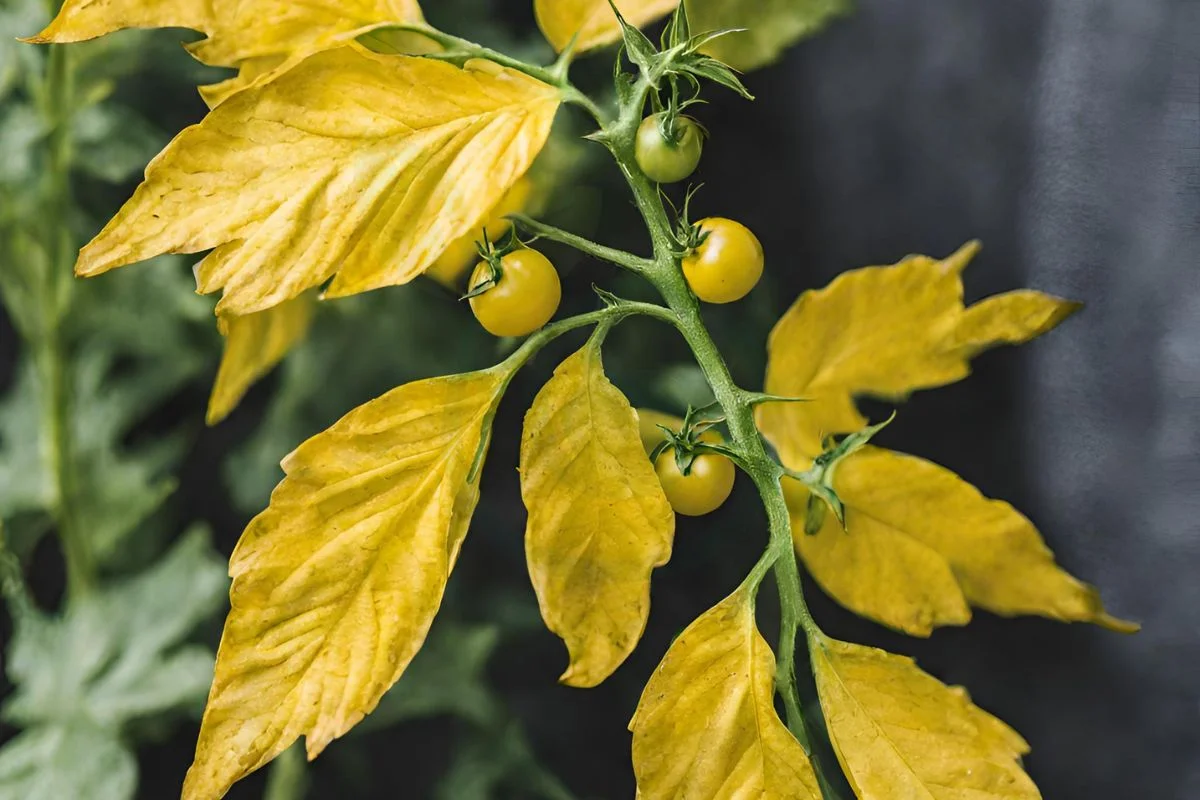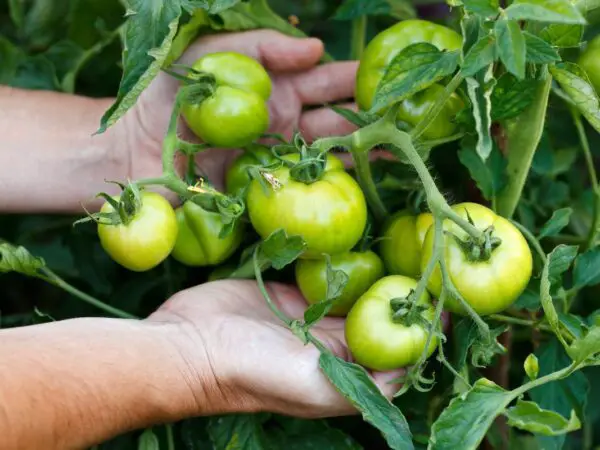Did you know that leaf yellowing on the foliage of a tomato plant could signal underlying issues with your beloved garden crops? If you're wondering "what does leaf yellowing on a tomato plant in a vegetable garden mean," fret not! We've got you covered with expert insights and solutions to get those tomatoes in the vegetable garden thriving again.
Yellowing foliage on your tomato plants may indicate nutrient deficiencies, overwatering, pests, or even diseases. In this comprehensive guide, we'll delve into the reasons behind this common gardening woe and provide practical tips to address each cause effectively. From proper watering techniques to diagnosing potential diseases, we'll equip you with the knowledge needed to ensure your tomato plants stay healthy and vibrant.
Curious to learn more about maintaining robust tomato plants? Let's explore further in the upcoming sections.
Key Takeaways
- Decoding Yellow Leaves on tomato plants can indicate various issues, from nutrient deficiencies to diseases, requiring careful observation and prompt action.
- Understanding Nutrient Needs is crucial for maintaining healthy tomato plants; ensure proper fertilization with balanced nutrients to prevent yellowing leaves.
- Water Management Essentials involve providing consistent moisture levels, avoiding both overwatering and underwatering, to keep tomato plants thriving and leaf discoloration at bay.
- Combatting Diseases and Pests promptly is essential to prevent yellow leaves caused by infections or infestations; use appropriate treatments or preventive measures.
- Implementing Good Gardening Practices such as proper spacing, regular pruning, and sanitation can help reduce the risk of yellowing leaves on tomato plants.
- Enhancing Plant Health through proper care, monitoring for early signs of stress or disease, and adjusting growing conditions as needed can promote vibrant, green foliage and optimal fruit production.
Decoding Yellow Leaves
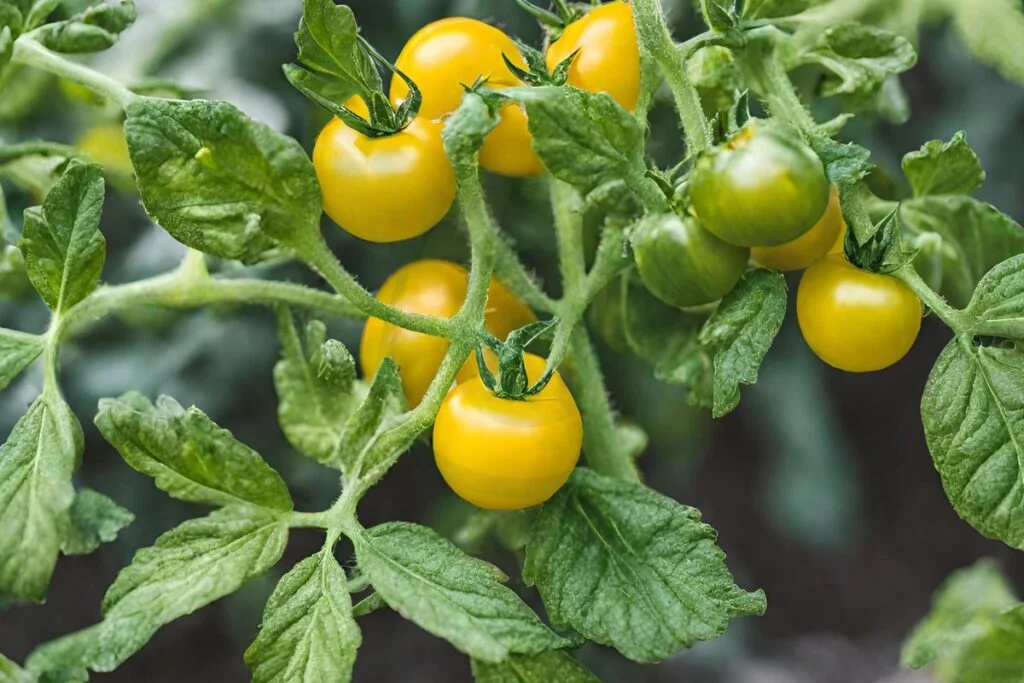
Common Causes
Yellow leaves on tomato plants can be attributed to various factors such as nutrient deficiencies, diseases, pests, and cultural problems. Identifying the specific cause is crucial for effective treatment. Factors like overwatering, poor soil quality, or inadequate sunlight can contribute to leaf yellowing.
Nutrient Deficiency
Nutrient deficiencies play a significant role in causing yellow leaves on tomato plants. Lack of essential nutrients like nitrogen, potassium, or magnesium can lead to discoloration. Conducting soil tests can help determine the specific deficiency and guide appropriate fertilizer application to rectify the issue.
Diseases and Pests
Diseases and pests pose a threat to tomato plant health, resulting in yellow foliage. Common culprits include fungal infections like early blight or pests such as aphids. Seeking professional assistance for accurate diagnosis is crucial. Early detection of diseases and pests is vital for implementing timely preventive measures.
Cultural Problems
Improper watering practices are often linked to nutrient deficiencies that manifest as yellowing leaves on tomato plants. Inconsistent watering schedules, either too much or too little water, can stress the plants and lead to leaf discoloration. Maintaining a balanced watering routine is essential for plant health.
Understanding Nutrient Needs
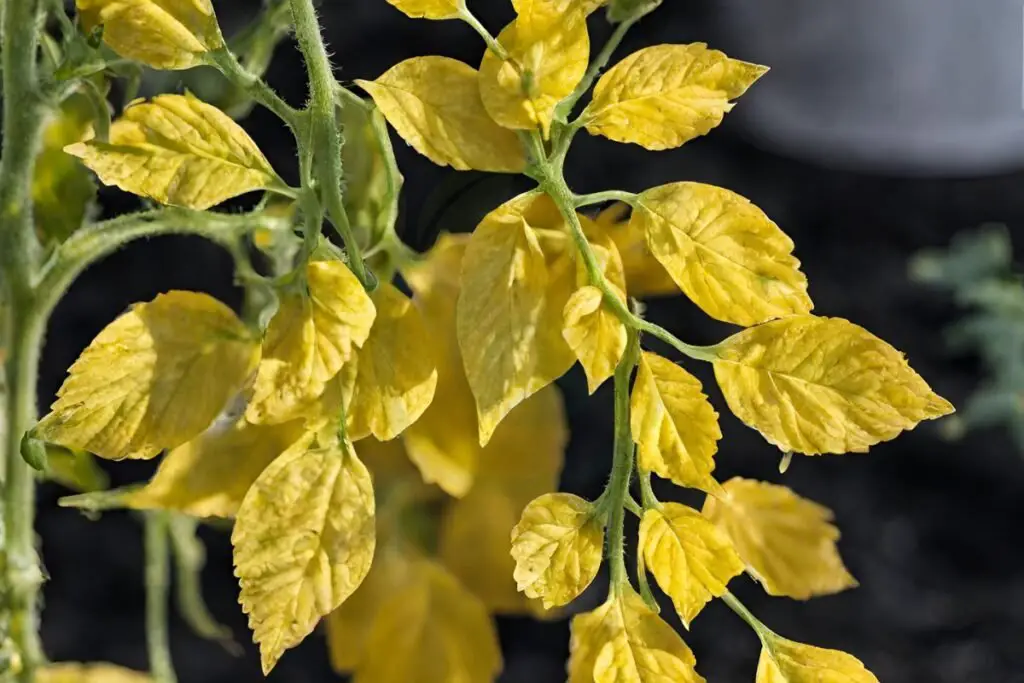
Tomato plants require specific nutrients to thrive, with each playing a crucial role in their growth. Nitrogen aids in leaf development, while phosphorus supports root growth and flower formation. Potassium, on the other hand, helps with overall plant health.
When tomato plants lack essential nutrients, yellow leaves are a common sign of deficiency. Nitrogen deficiency leads to pale yellow older leaves, while phosphorus deficiency causes dark green leaves with purple undersides. Potassium deficiency results in yellowing leaf edges.
Maintaining a balanced nutrient profile is vital for healthy tomato plants. By ensuring they receive adequate amounts of nitrogen, phosphorus, and potassium, gardeners can prevent yellowing leaves and promote robust growth.
To identify nutrient deficiencies in tomato plants, look for specific symptoms. Yellowing between veins indicates nitrogen deficiency, while purplish leaves signal a lack of phosphorus. Brown spots or curling leaf edges may point to potassium deficiency.
Visual cues like leaf discoloration and unusual patterns can help gardeners pinpoint the exact nutrient issue affecting their tomato plants. Early detection of these symptoms is crucial for prompt intervention and effective treatment.
Early intervention is key to correcting nutrient imbalances in tomato plants. Begin by testing the soil to determine which nutrients are lacking. Then, adjust fertilization practices accordingly to address specific deficiencies.
Addressing nutrient imbalances involves targeted actions tailored to the specific needs of tomato plants. By applying nitrogen-rich fertilizer for nitrogen deficiencies, phosphorus-heavy fertilizer for phosphorus issues, and potassium-enriched products for potassium deficits, gardeners can restore optimal nutrient levels.
Frequent monitoring of soil nutrient levels is essential for maintaining healthy tomato plants. Regularly testing the soil and adjusting fertilization regimes based on deficiencies ensure that the plants receive the necessary nutrients for vigorous growth.
Water Management Essentials
Proper Watering Techniques
Proper watering techniques are crucial in preventing yellow leaves on a tomato plant. Deep and infrequent watering encourages roots to grow deeper, promoting plant stability and resilience. Water plays a vital role in nutrient absorption and overall plant health.
Maintaining the right moisture balance is essential for healthy tomato plants. By watering deeply, you ensure that the roots receive adequate hydration, preventing issues like yellowing leaves. Infrequent watering also helps in preventing waterlogged soil, which can lead to root rot.
Signs of Over/Underwatering
Signs of overwatering include wilting despite moist soil, while underwatering leads to dry and crispy leaves. Adjust watering practices based on the plant's needs; monitor the soil moisture regularly to prevent extremes. Finding the right balance ensures optimal growth and minimizes stress on the plant.
Yellow leaves can signal both over and underwatering issues. Adjust watering frequency based on weather conditions and plant development stages. Consistent monitoring of soil moisture levels is key to ensuring that your tomato plants thrive. Remember, maintaining proper hydration is vital for their overall health.
Combatting Diseases and Pests
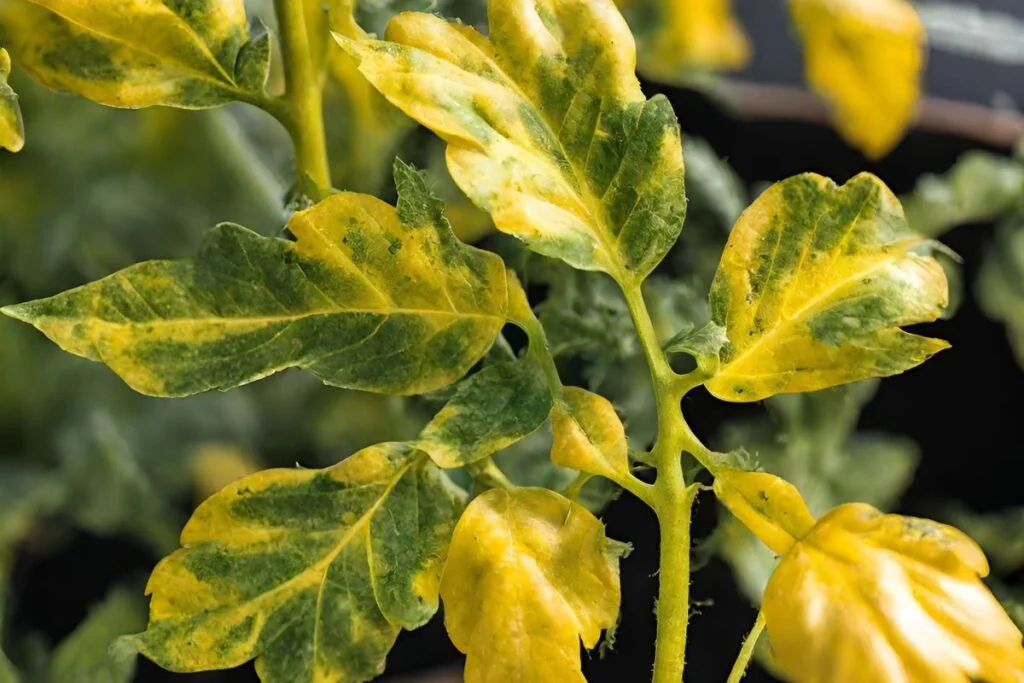
Common Culprits
Yellow leaves on a tomato plant can signal more than just nutrient deficiencies. Pests like aphids and whiteflies are common culprits, causing stress to plants. Environmental factors such as excessive heat or cold can also lead to yellowing.
When addressing yellow leaves, it's crucial to consider all possible causes. Multiple issues, including diseases like blight and pests, may be at play. Regular monitoring of plants is essential for early detection and treatment.
Prevention Strategies
To prevent yellow leaves, focus on maintaining optimal soil conditions. Regularly check the pH levels and ensure proper drainage to prevent waterlogging. Implement crop rotation to reduce disease buildup in the soil.
Proactive measures like applying organic mulch can help retain moisture and regulate soil temperature. Consider using natural predators like ladybugs to control pest populations without harmful chemicals.
Treatment Options
For treating yellow leaves, consider addressing any underlying nutrient deficiencies with appropriate fertilizers. Use compost tea or organic fertilizers rich in nitrogen for healthy leaf growth. Prune affected leaves to prevent the spread of diseases.
Consider using neem oil as a natural pesticide against common tomato plant pests. Implementing biological controls, such as beneficial nematodes, can effectively combat harmful insects without harming beneficial ones.
Addressing Cultural Problems
Herbicide Damage
Herbicides can negatively affect tomato plants, leading to yellow leaves due to chemical exposure. Symptoms include leaf curling and browning edges. To identify herbicide damage, look for distorted growth patterns and stunted development.
Strategies to mitigate herbicide-related issues include avoiding contaminated soil, using organic fertilizers, and ensuring proper watering to flush out toxins.
Environmental Stress
Environmental factors like extreme temperatures and inadequate sunlight can cause yellow leaves on tomato plants. High temperatures may lead to wilting and discoloration, while insufficient sunlight can hinder photosynthesis.
Protect plants from environmental stress by providing adequate shade during scorching heat, mulching to retain moisture, and adjusting watering schedules based on weather conditions.
Enhancing Plant Health
Soil Quality Improvement
To enhance plant health and prevent yellow leaves on tomato plants, improving soil quality is crucial. Start by adding organic matter like compost to boost nutrient levels in the soil. Aim for a pH balance between 6.0 and 6.8 to ensure optimal nutrient uptake by the plants.
When addressing soil quality, consider incorporating soil amendments such as bone meal or fish emulsion to provide essential nutrients for healthy growth. These amendments can help prevent nutrient deficiencies that lead to yellowing leaves on tomato plants. Regular soil testing can guide you in adjusting nutrient levels effectively.
- Add compost for nutrient boost
- Maintain pH balance between 6.0 and 6.8
- Consider using soil amendments like bone meal or fish emulsion
Fertilization Practices
Proper fertilization practices are key to maintaining healthy tomato plants and preventing yellow leaves. Opt for a balanced fertilizer with equal parts of nitrogen, phosphorus, and potassium (NPK) to promote robust growth and prevent deficiencies that cause leaf discoloration.
Balanced fertilization ensures that your tomato plants receive all the necessary nutrients for optimal growth and development. Before applying any fertilizer, conduct a soil test to determine the specific nutrient needs of your plants and choose a fertilizer accordingly.
- Use balanced NPK fertilizer
- Conduct a soil test before fertilizing
Selecting the Right Varieties
Disease Resistance
Tomato plants can be susceptible to various diseases, impacting their overall health. To enhance disease resistance, start by choosing tomato varieties known for their resilience. Opt for varieties that boast strong disease resistance traits, such as Early Girl or Celebrity. These varieties are less prone to common tomato diseases like blight and wilt. Ensure your plants are grown in nutrient-rich soil to boost their immunity. Nutrient deficiencies can weaken plants, making them more vulnerable to diseases. By providing the necessary nutrients, you can help your tomatoes fight off potential infections effectively. When selecting tomato varieties, prioritize those labeled as disease-resistant. These varieties have been specifically bred to withstand common diseases, offering a higher chance of a successful harvest.
Climate Adaptability
The climate plays a crucial role in determining the health and appearance of tomato plants, including leaf color. To ensure your plants thrive despite varying climate conditions, consider strategies for climate adaptability. Tomatoes are sensitive to extreme temperatures, so it's essential to protect them from harsh weather conditions like excessive heat or cold snaps. Implement shading techniques during scorching summers and provide adequate insulation during chilly winters to shield your plants from temperature extremes. Adjust watering schedules based on the prevailing climate to prevent water stress in your tomatoes. By adapting your cultivation practices to suit the local climate, you can promote healthier growth and vibrant leaf colors in your tomato plants.
Implementing Good Gardening Practices
Plant Spacing
Proper plant spacing is crucial for ensuring healthy tomato plants. When tomatoes are overcrowded, they compete for nutrients, sunlight, and space. This competition often results in nutrient deficiencies, leading to the development of yellow leaves. To avoid this issue, it's essential to follow specific guidelines on spacing tomato plants.
Maintaining adequate distance between tomato plants allows each plant to access sufficient sunlight and nutrients from the soil. By providing ample space, you reduce the risk of nutrient deficiencies that can manifest as yellowing leaves. For determinate varieties, aim for a spacing of 18-24 inches apart, while indeterminate types should be spaced 24-36 inches apart to thrive optimally.
Companion Planting
Companion planting offers numerous benefits for tomato plants by enhancing soil health and preventing nutrient deficiencies that cause yellow leaves. Certain plant combinations can improve nutrient uptake and overall growth. Pairing tomatoes with basil or marigolds can deter pests and promote healthier soil conditions conducive to robust tomato growth.
Selecting compatible companion plants is key to maximizing the benefits of companion planting. Plants like basil not only repel pests but also enhance the flavor of tomatoes when grown together. Marigolds help in controlling nematodes in the soil, benefiting the overall health of tomato plants. Consider planting chives or carrots alongside your tomatoes to further boost their growth and resilience.
Preventative Measures for Healthy Plants
Regular Monitoring
Regularly monitoring tomato plants is crucial for early detection of any issues that may arise. By observing the plant's health indicators, such as leaf color and growth patterns, you can address problems promptly. Establish a monitoring schedule to check for yellow leaves, pests, or diseases.
Seasonal Care Tips
Maintaining healthy tomato plants year-round requires seasonal care adjustments. Understand how seasonal changes affect plant health and nutrient absorption. Adjust your care routines based on the specific needs of tomato plants during different seasons.
Closing Thoughts
Understanding the reasons behind yellow leaves on your tomato plants is vital for maintaining a healthy garden. By decoding these signs, addressing nutrient deficiencies, managing water effectively, and implementing good gardening practices, you can enhance your plant's health and productivity. Combatting diseases, pests, and cultural problems will further ensure the well-being of your tomato plants. Remember to select the right varieties and apply preventative measures diligently to promote optimal growth.
Take action today by applying the knowledge gained from this article to revitalize your tomato plants. Share these tips with fellow gardeners to create a community of thriving gardens. Your efforts will not only result in vibrant tomato plants but also a fulfilling gardening experience.
Frequently Asked Questions
What causes yellow leaves on a tomato plant?
Yellow leaves on a tomato plant are often caused by nutrient deficiencies, such as nitrogen, magnesium, or iron. Overwatering, diseases like early blight or pests like spider mites can also lead to yellowing.
How can I address yellow leaves on my tomato plant?
To address yellow leaves, first identify the underlying cause - whether it's a nutrient deficiency, overwatering, disease, or pests. Adjust watering practices, fertilize with balanced nutrients, and treat any diseases or pests promptly.
Why is water management important for tomato plants with yellow leaves?
Proper water management is crucial for tomato plants with yellow leaves as overwatering can lead to root rot and nutrient leaching while underwatering can cause stress and nutrient deficiencies. Maintaining consistent moisture levels is key for plant health.
How do I combat diseases and pests causing yellow leaves on my tomato plant?
Combat diseases by practicing good sanitation, using disease-resistant varieties, and applying organic fungicides when needed. For pests like aphids or whiteflies, introduce natural predators or use insecticidal soaps to control infestations effectively.
What cultural problems should I address if my tomato plant has yellow leaves?
Cultural problems like improper planting depth, lack of sunlight, overcrowding, or poor soil quality can contribute to yellow leaves on tomato plants. Ensure your plants have adequate spacing, sunlight exposure, well-draining soil, and proper care practices.
Image Source: Paid image from CANVA

